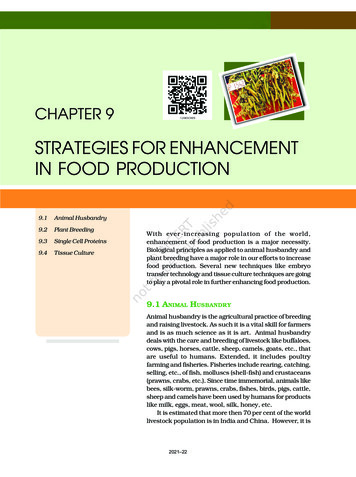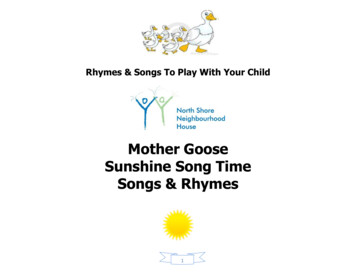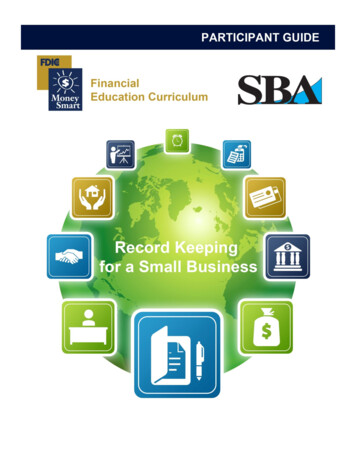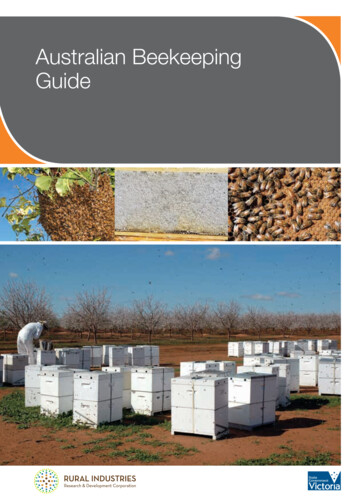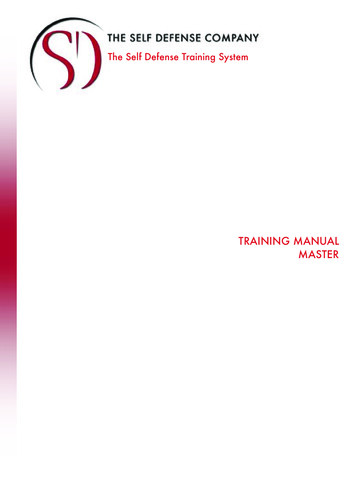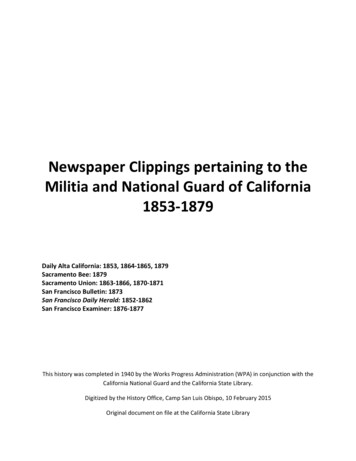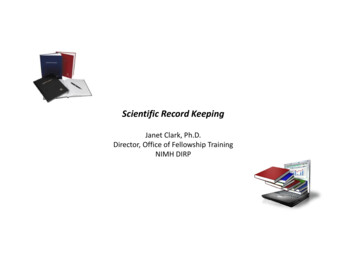
Transcription
THE REPUBLIC OF UGANDAMinistry of Education and SportsMINISTRY OF AGRICULTURE, ANIMAL INDUSTRY AND FISHERIESTHE NATIONAL BEE KEEPINGTRAINING AND EXTENSIONMANUALFARM INCOME ENHANCEMENT AND FOREST CONSERVATION PROJECTAPICULTURE PROMOTION SUB COMPONENTFunded by:THE AFRICAN DEVELOPMENT BANK AND GOVERNMENT OF UGANDA March 2012
The NationalBee KeepingTraining and ExtensionManualFunded by:-THE AFRICAN DEVELOPMENT BANK AND GOVERNMENT OF UGANDA
Edited by:1. Ms. Kangave Alice,2. Mr. Butele Cosmas Alfred,3. Mr. Onzoma Apollo, and4. Mr. Kato AgapitusiiNational Bee keeping training and extension manual, 2012
TABLE OF CONTENTSEditors .Table of ContentsList of Figures .List of tables .Foreword.AcknowledgementsList of Acronyms.iiiiiivvviviiviiiIntroduction .ixTHE HONEYBEE AND ITS IMPORTANCE.1Module 1:Module 2:Module 3:.157.11.1114365463667074798385909398CHAPTER ONE:Bee Biology and Behaviour.The Importance of Beekeeping .Pollination.CHAPTER TWO:MANAGEMENT OF THE HONEYBEEModule 4:Module 5:Module 6:Module 7:Module 8:Module 9:Module 10:Module 11:Module 12:Module 13:Module 14:Module 15:Module 16:Module 17:.Beekeeping Systems .Beekeeping Equipment .Making Beekeeping EquipmentApiary Management .The Floral Calendar and BeekeepingBee Stings and Management .Hive Inspection.Populating the Hive .Catching a Swarm.Transferring Bees.Dividing and Uniting Colonies .Feeding of Bees.Bee Pests, Predators and DiseasesMaking Bio-Pesticides .CHAPTER THREE:HIVE PRODUCTS AND PROCESSING.102Module 18:Module 19:Module 20:Module 21:.102106110114EXPLANATION OF COMMON BEEKEEPING TERMS .APPENDICES.125127Appendix 1:Appendix 2:References:.127128129Hive Products .Quality Honey HarvestingProcessing Honey.Beeswax.CHAPTER FOUR:.National Bee keeping training and extension manual, 2012.iii
LIST OF FIGURESFig. 1:Fig. 2:Fig. 3:Fig. 4:Fig. 5:Fig. 6:Fig. 7:Fig. 8:Fig. 9:Fig. 10:Fig. 11:Fig. 12:Fig. 13:Fig. 14:Fig. 15:Fig. 16:Fig. 17:Fig. 18:The honeybee castes in a colony .Diagram of the lifecycle of the honey bee .Peanut-shaped queen cell .Queen cells.Pebbly textured drone cells.The worker bee visiting a flower, helping to pollinate the plant .Measurements for woven basket hive.Woven basket hive.The log hive.Clay hives .Picture of Johnson hive .KTB hive showing how the comb attaches to the bar inside the hive.A top bar lifted from a KTB hive .A KTB hive being opened .Catcher box for a KTB hive .Langstroth hive showing the different parts of the hive .Langstroth hive .Langstroth hive- brood chamber, empty frame, honey chamber, combed frame, queenexcluder, cover.Fig. 19:Catcher box for a Langstroth.Fig. 20:Frame brick hive .Fig. 21:Bee smokers.Fig. 22:Bee suit .Fig. 23:Soft latex gloves .Fig. 24:Bee brushes.Fig. 25:Hive openers.Fig. 26:Knife.Fig. 27:Airtight bucket (food grade).Fig. 28:Food grade drum .Fig. 29:Honey Refractometer.Fig. 30 (a): Straining cloth.Fig. 30 (b): Straining cloth tied around a bucket ready for straining honey.Fig. 31:Centrifuge extractor.Fig. 32:Honey settling tank.Fig. 33:Honey press.Fig. 34:Honey jars .Fig. 35:Bee house .Fig. 36:Dimensions for the body of a Kenyan Top Bar hive.Fig. 37:Top bar measurements .Fig. 38:Langstroth hive dimensions.Fig. 39:Solar wax extractor.Fig. 40:Bee veil .Fig. 41:Dimensions of bee veil.Fig. 42:Bee veil parts.Fig. 43:Bee veil plan.Fig. 44:Overall plan.Fig. 45:Measurements of bee glove.Fig. 46:Measurements and making of a bee ional Bee keeping training and extension manual, 2012
Fig. 47:Fig. 48:Fig. 49:Fig. 50:Fig. 51:Fig. 52:Fig. 53:Fig. 54:Fig. 55:Fig. 56:Fig. 57:Fig. 58:Fig. 59:Fig. 60:Fig. 61:Fig. 62:Fig. 63:Floral calendar.Comb.Catching a swarm .Transferring bees .Dividing a colony .Opening an old weak colony for uniting with a swarm.The appearance of queen cells and queen cups .Farmers selling honey-wine at a show.Hoima Natural Honey on display .A pollen trap.Uncapping fork .Different types of honey press and locally made bottling containersA sketch and picture of a honey centrifuge extractor.Melting wax.Wax extraction using a sack and a drum .Wax extraction with cloth and sticks.Sketch of a solar wax extractor 26264113LIST OF TABLESTable 1:Table 2:Table 3:Table 4:Table 5:Table 6:Lifespan of bees .An example of a hive/colony record sheet .Visitors’ Book.Cash Book .Floral calendar.Forms of honey and how they are made .National Bee keeping training and extension manual, 2012.v
FOREWORDIt is everybody’s concern to see that the rural communities generate sustainable incomes as soon aspossible. Livestock production and marketing offers an option. Out of the various livestock enterprises,namely, poultry, fisheries, cattle, piggery, etc beekeeping enterprise offers one of the best optionsfor the rural communities and commercial farmers because of its minimal requirements for land,machinery and equipment, labor and capital investment.In Uganda, honey production potential is enormous, estimated at 500,000 metric tones per year.This potential is not yet fully exploited. The basic knowledge and skills needed to exploit the honeyproduction potential are lacking among the technocrats and farmers.Over the years, several stakeholders including Government Ministries, Departments and Agencieshave been carrying out training of farmers in their own ways without standard guide and uniformity.Some of the guides/manuals used by the stakeholders are substandard. This practice has for longundermined efforts to increase production and enforce compliance to standards.This manual has therefore been developed to provide the basic standards for training beekeepers allover Uganda.It is my sincere hope that trainers, extension workers, farmers and students will find this manual veryvaluable.Okaasai S. OpolotFor: PERMANENT SECRETARYviNational Bee keeping training and extension manual, 2012
ACKNOWLEDGEMENTSWe are very much grateful to the African Development Bank (ADB) and Government of Uganda (GoU)for funding the FIEFOC Project which has produced this very important National Beekeeping Trainingand Extension Manual. For sure this manual will guide teachers, trainers, students, farmers andbeekeepers.We appreciate and acknowledge the following people who provided literature without which thismanual would not have been produced:Mr. Kato Agapitus, Entomologist, Mukono, DLG; Mr. Ayo George, DEO, Lira DLG; Mr. Rubaihayo John,DEO, Kabarole DLG; Mr. Mugume Amos, DAO, Kabarole DLG; Mr. Bagonza Adolf, Kabarole Beekeepers’Association, Kabarole District; Mr. Ayatuhaire Asaph , West Honeys Uganda, Mbarara District; Mr.Kanyike Charles, DEO, Nakasongola DLG; Mr. Palanda Robert Obumai, Assistant Entomologist, AdjumaniDLG; Mr. Ochoun Emirious, Private Service Provider, Nebbi District; Mr. Lule Henry, DEO, Luwero DLG;Mr. Kefa John, Moyo Beekeepers’ Association, Moyo District; Mr. Amafua Morphat, Private ServiceProvider, Yumbe District; Mr. Kawawa Rashid, DEO, Yumbe DLG; Mr. Cema Philliam, DEO, Arua DLG;Ms. Kesubi Nice Alex, BNU, Arua District; Babua Fred, Arua Moyo Nebbi Beekeepers’ Association,Arua District; Mr. Khauka Edmond, Beemaster, Mbale DLG; Mr. Ogwoli Geoffrey, DEO, Sironko DLG;Mr. Kisaali Bosco, Private Service Provider, Sironko District; Nyangas Simon, Private Service Provider,Kapchorwa District; Mr. Oluka Michael, DEO, Bukedea DLG; Mr. Esima Mike, Private Service Provider,Soroti District; Mr. Kwikiriza Jibril, Ag. DEO, Masindi DLG; Mr. Mugisha Daudi, Assistant Entomologist,Hoima DLG; Mr. Kasangaki Patrice, DEO, Kibaale DLG; Mr. Kasereka J. Muranga, Rwenzori MountainsDevelopment Organization (REMODA), Kasese District; Mr. Besekya Hilary, Tropical Bee Care Centre,Bushenyi District; Mr. Tumuhimbise Gordon, DEO, Bushenyi DLG; Mrs. Margaret Rose Ogaba, KitgumWomen Beekeepers’ Association (KWOBA); Kaddu John (2012) Bee keeping equipment manufacturerand trainer Kampala, Uganda.Thanks to all the people who participated actively in constructive discussions during workshopsorganized, but not mentioned here.Last but not least, great thanks to Mrs. Kangave Alice, Principal Entomologist Productive Insects/ManagerApiculture Promotion Sub Component of FIEFOC Project, DLH&E, MAAIF Hqtrs; Mr. Butele CosmasAlfred, Senior Entomologist Apiculture, DLH&E, MAAIF Hqtrs; and Mr. Onzoma Apollo, Senior TrainingOfficer, HRD, MAAIF Hqtrs for having compiled the literature and views provided, and editing.Dr. Nicholas KautaCOMMISSIONER, LIVESTOCK HEALTH AND ENTOMOLOGYNational Bee keeping training and extension manual, 2012vii
List of AcronymsADB-African Development BankBNU-Bee Natural Uganda LtdBQV-Black Queen Virus diseaseDAO-District Agricultural OfficerDEO-District Entomology OfficerDLG-District Local GovernmentDLH&E-Department of Livestock Health and EntomologyFIEFOC-Farm Income Enhancement and Forest Conservation ProjectFIG-FigureGoU-Government of UgandaHIV/AIDS-Human Immune Virus/Acquired Immune Deficiency SyndromeHqtrs-HeadquartersHRD-Human Resource DepartmentHrs-HoursKBA-Kabarole Beekeeper’s AssociationKTB-Kenya Top Bar beehivesKWOBA-Kitgum Women Beekeepers’ AssociationMAAIF-Ministry of Agriculture, Animal Industry and FisheriesMBA-Moyo Beekeeper’s AssociationNAC-National Apiculture CentreNGO-Non-Governmental OrganizationPE-Principal EntomologistPSP-Private Service ProviderREMODA-Rwenzori Mountains Development OrganizationSE-Senior EntomologistSTO-Senior Training OfficerTVs-TelevisionsviiiNational Bee keeping training and extension manual, 2012
INTRODUCTIONOver the years several private service providers, NGOs, Projects, Government agencies and departmentshave been carrying out training of farmers in beekeeping in their own ways without uniformity. In otherwords there have been many different training manuals/guides being used by the different stakeholders inthe apiculture industry, some of which are sub-standard. This practice has for long undermined efforts toenforce compliance to code of practice, standard operating procedures and quality standards in apicultureindustry, hence the need for harmonization and uniformity.The African Development Bank and the Government of Uganda through the Farm Income Enhancementand Forest Conservation (FIEFOC) Project, under Apiculture Promotion sub-component embarked on aseries of interventions which include among others, standardization of the national training document.The project therefore provided funds to develop a national beekeeping training and extension manual as astrategy to promote compliance to standards in beekeeping industry in Uganda.The process of developing the national bee keeping training and extension manual had stages and startedin February 2009 with field trips organized for collection of literature from various regions and districts (seeappendix 1). This was followed with a 2 day retreat, organized for selected entomologists and private serviceproviders at Ulrika Guest House, Kisubi, 7th - 8th May 2009 (see appendix 2). The aim of the retreat was toconsolidate and analyse the literature collected and come up with standard modular training manual foruse throughout Uganda. The first draft manual was produced and several consultative workshops followedto finalize it.The manual is categorized into four(4) broad chapters, namely:(1)The Honeybee and its importanc(2)Management of the Honeybee(3)Hive Products and processing, and(4)Explanation of common beekeeping terms.This National Beekeeping Training and Extension Manual have been developed to streamline and harmonizethe beekeeping training and extension for the stakeholders involved in the Industry. It will later be translatedinto major languages of Uganda in order to promote its usage and adoption.National Bee keeping training and extension manual, 2012ix
CHAPTER ONETHE HONEY BEE AND ITS IMPORTANCEMODULE 1: BEE BIOLOGY AND BEHAVIOURINTRODUCTIONThere are various types of bees which include the stingless bees, solitary bees, honey bees. This manualfocuses on honey bees.Honey Bees belong to the animal kingdom, Phylum Arthropoda, Order Hymenoptera, class Insecta, Superfamily Apoidea, family Apidae, genus Apis. The genus Apis is divided into several species and sub-species/races but the 5 main species are: Apis dorsata (the giant honeybee), Apis laboriosa (the darker gianthoneybee), Apis florea (the dwarf honeybee), Apis cerana and Apis mellifera. Research needs to be done toascertain the major species available in Uganda.Honey bees are social insects that live in colonies of 10,000 to 60,000 bees. A colony consists of a queen(fertile female), a few hundred drones (males) and thousands of workers (sterile females). They pollinateflowering plants and crops. They also produce honey, beeswax and other bee products of very high economicvalue.Learning objectivesBy the end of the session, participants will be able to:1)Identify the different castes of honey bee colony.2)State the roles played by the different castes in a honey bee colony.3)Explain the life cycle of the different bee castes.Target Participants:Beekeepers, extension service providers, individuals and organizations/Institutions.Suggested Number of Participants:A maximum of 30 personsDuration:2 hours.MaterialstFlip chart and masking tape or chalkboard, marker pens or chalk, notebooks and pens, bees and/orpictures of bees, TVs, Projectors, generators, films about bees and hand outs.MethodstLecturetBrainstormingtGroup discussiontField exercise to identify the different castes in a bee colonySteps:Step 1Write the title “Bee biology and behavior” on the chalkboard or flip chartNational Bee keeping training and extension manual, 20121
Step 2Engage the participants to brainstorm on the meaning of bee biology and behavior.Step 3Explain bee biology and behavior to the participantsStep 4Allocate the participants in 3 groups and assign them the following tasks:Group 1:Discuss the roles played by the different castes in a bee colonyGroup 2:Describe the life cycle of different honey bee castesGroup 3:Discuss the behavior of the bee in different seasons of the yearStep 5In plenary, participants present findings, the trainer clarifies, summarizes and gives out the hand outs.HAND OUT: Bee Biology and BehaviourThere are various types of bees which include the stingless bees, solitary bees, honey bees. This manualfocuses on honey bees.Honey Bees belong to the animal kingdom, Phylum Arthropoda, Order Hymenoptera, class Insecta, Superfamily Apoidea, family Apidae, genus Apis. The genus Apis is divided into several species and sub-species/races but the 5 main species are: Apis dorsata (the giant honeybee), Apis laboriosa (the darker gianthoneybee), Apis florea (the dwarf honeybee), Apis cerana and Apis mellifera. Research needs to be done toascertain the major species available in Uganda.1.Castes in a bee colonyHoney Bees are social insects that live in colonies of about 10,000 to 60,000 bees. A colony consistsof a queen (fertile female), a few hundred drones (males) and thousands of workers (sterile females).They pollinate flowering plants and crops.Bees:Fig.1: The honeybee castes in a colonyQueen beeThe Queen bee is a reproductive female. There is only one queen in the hive and her job is to lay eggs andproduce queen substance (pheromones). When a new queen starts life, she mates only once with dronesoutside the hive. A good queen lays between 1,500 - 2,000 eggs per day but after two years she lays fewer2National Bee keeping training and extension manual, 2012
eggs. She lives for three to five years. It is very difficult to find the queen but she can be recognized byher long and slender body and short wings. She is fed by the young workers and is bigger than the otheroccupants due to massive feeding especially with royal jelly. She has a sting that is only used against rivalqueens. Her pheromones or scents serve to control the other bees and harmonize the colony’s behaviour.The Queen bee can be marked on the dorsal surface of the abdomen for easy identification and to avoidbeing crushed accidentally during hive manipulations.DronesThe Drones are males and are bigger than the workers. They develop from unfertilized eggs and their majortask is to mate with the queen. They are stingless, very large eyes which are used to spot the Queen duringmating. Drones look large and square and make a loud buzzing noise when they fly. Drones are dependenton the workers for food because their proboscis is short and cannot collect food for them. There can beabout 200 to 500 drones in a hive but in time of food shortage the workers chase the drones out of the hiveto die. Their lifespan is usually not more than 2 months.The WorkersMost of the bees in the hive are workers- they are all sterile females. The worker bees’ change tasks accordingto age. Young worker bees clean the hive, feed both young and the Queen and make the beeswax combs.They control the temperature of the hive by flapping their wings and also guard the hive. Older workersscout for food and collect the pollen, nectar, water and propolis. They have a sting plus special glands andorgans to help them to defend the colony against enemies. The workers are also responsible for the honeyformation process.The lifespan of a worker bee is 7-8 weeks during the main flowering season when they work hard. They canlive longer during dormant periods.2.Life cycle of a beeEach bee in the course of its life passes through 4 stage metamorphosis: Egg Larva Pupa Adult.During the development stages, the eggs, larvae and pupae are known as brood.Fig.2: Diagram of the life cycle of the honeybeeThe egg laid by the queen looks like a small grain of rice or hair nit. Whether an egg will develop into aqueen, drone or worker depends on the type of cell it is laid in (it is very important to learn the differencebetween capped brood and capped honey – capped brood is usually dark brown and capped honey is usuallywhite or creamy in colour).The egg develops into larva, which looks like a white maggot. All larvae are fed on royal jelly for the firstNational Bee keeping training and extension manual, 20123
three days after which larvae for workers and drones are fed on pollen (bee bread) and honey put into thecell by the nurse bees (younger worker bees). The queen feeds on royal jelly throughout the life.Fig.3: Peanut-shaped queen cellFig.4: Queen cellsFig.5: Pebbly textured drone cellsThe larvae are sealed with a wax capping in the comb after six days where they turn into pupae and lateremerge as adult bees as shown in the table below.Table 1: Life span of beesCasteEggLarvaePupaeTotal daysWorker3611 - 1221Queen366-716Drone38-912 - 13243.Communication in beesBees communicate with one another in a number of ways such as drumming feet, flapping wings likea ‘dance’ and use of pheromones. The dance performed by the scout bees is one way the bees informeach other of the location of food and how far away it is. There are several types of dances performedby the bees, but the main ones are the round dance and the waggle dance. The round dance isperformed by bees that forage less than approximately 100 metres from the hive. Waggle dance isperformed to locate food source beyond 100 metres from the hive. The scout bees also perform acharacteristic dance to locate the new found home to which bees intend to swarm.4National Bee keeping training and extension manual, 2012
The queen releases a substance called a “pheromone” (sometimes called queen substance) whichserves different functions. The pheromone enables her to identify members of the colony, to inhibitovary development in worker bees, to prevent the workers from building queen cells, to help a swarmor colony to move as a cohesive unit, and to attract drones during mating flights. The absence of thequeen substance (e.g. when the queen dies) produces opposite responses, i.e. worker bees begin todevelop ovaries and to build queen cells, and a swarm searching for accommodation will not clusterbut will divide into smaller groups that cannot support the normal life of a bee colony.Colony decisions are taken by the collective behaviour of bees within one colony sharing the sameodour, allowing guard bees to detect intruders.MODULE 2: THE IMPORTANCE OF BEEKEEPINGIntroductionBeekeeping is the science and art of rearing bees. It is important to keep bees for the production of honey,beeswax, propolis, pollen (bee bread), royal jelly and bee venom; for food, medicine and income. Beekeepingis also important for pollination and recreational activities.Learning ObjectivesBy the end of the session, participants will be able to:1.Understand and appreciate the importance of beekeeping in the society.2.Describe the importance of the various bee products and services.Target Participants:Beekeepers, extension service providers, individuals and organizations / InstitutionsSuggested Number of Participants:A maximum of 30 personsDuration:2 hours.MaterialstFlip chart and masking tape or chalkboard, marker pens or chalk, notebooks and pens, bee productsand flowers and fruits/ their pictures, posters, TVs, Projectors, generators, films about bee productsand services, and hand outs.MethodstLecturestBrainstormingtGroup discussionstCase studiesSteps:Step 1Write the title “THE IMPORTANCE OF BEEKEEPING” on the chalkboard or flip chart and introduce it.Step 2Engage the participants to brainstorm on why it is important to keep bees.National Bee keeping training and extension manual, 20125
Step 3Allocate the participants in 2 groups and assign them the following tasks:Group 1:Discuss the importance of beekeepingGroup 2:Explain the importance of each bee product or serviceStep 4In plenary, participants present findings, the trainer clarifies, summarizes and gives out the hand outs.HAND OUT: The importance of BeekeepingBeekeeping is the science and art of keeping bees using best practices. Beekeeping is very important, for theproduction of honey, beeswax, propolis, pollen (bee bread), royal jelly and bee venom; for food, medicineand income. Beekeeping is also important for pollination and recreational activities.There are various reasons for keeping bees, namely:-1.For cultural purposesHoney is used for beverage brewing and occasionally served at important cultural ceremonies suchas weddings. It is also served to very important guests as sign of high regard. The Maji Maji rebellionused bees as a weapon to defend themselves against the colonialists. Honey was used in Egypt ascosmetics and also for embalming the Egyptians dead pharaohs. Honey was among the tithes andoffertory given by the Jews to the Levites in their culture. In some African cultures honey is also usedto pay dowry.2.As source of foodHoney is delicious and nutritious. It is an important food for many people in Uganda. It is consumedwhole or mixed with other foods as supplement. Among the Langi and Acholi, honey is mixed withsimsim and groundnut paste. Bee brood (larvae and pupae) have high nutritional value and are fed tomalnourished children. Royal jelly and pollen are consumed for their high protein value.3.As source of medicineBee products such as bee venom, honey and propolis are used for treatment of many conditionsfollowing the antibiotic nature of the products. The conditions/diseases treated using bee productsinclude stomach upsets, diarrhea, vomiting, wounds, burns, cough, measles, false teeth, toothachesand fungal infections. It also helps to boost the immunity of people living with HIV/AIDS.4.For income generationThe honeybee products can be marketed locally or abroad to get money, with or without valueaddition. Beekeeping industry also provides incomes to various stakeholders in the value chain.These include bee farmers, artisans, pharmaceutical industry, food, beverage industry, honey dealersamong others.5.PollinationThe honeybees provide pollination services, thereby playing a vital role in food production and overallagricultural productivity. Over 75% of all the crops in sub Saharan Africa benefit from pollination.Bees are considered the most efficient pollinators because they have hairy bodies which easily pickup pollen grains as they move about in flowers. During a single day one bee may visit several hundredflowers. So bees are important to farmers. More bees means better pollination and high yields. Inother countries pollination by bees is hired and fetches additional money to the beekeeper.6.Conservation of natural resourcesBeekeeping is a non destructive activity that could be employed in the conservation of biodiversityin protected areas. Households living adjacent these areas can support the conservation efforts ofthese resources by establishing apiaries within or at the boundary of these protected areas.6National Bee keeping training and extension manual, 2012
Farmers realizing that vegetation is a source of forage for bees will guard against the destruction andbe encouraged to plant more plants for supplying pollen and nectar. In the process many plants areconserved and protected from destruction.7.HobbyOther people keep bees as a hobby.8.Api-Tourism and researchEstablishment of bee reserves for purposes of tourist attraction and research holds a big potentialfor the future.9.ApitherapyBee products are used in the treatment of many human ailments. For example, bee venom is animportant remedy for many ailments such as Arthritis, Parkinson disease and other diseases relatedto the nervous system. The venom can be obtained through bee stings.10.Beekeeping is a cheap undertaking(i)Beekeeping does not involve mass feeding of bees because in most cases the bees providetheir own food all year round.(ii)All the necessary inputs and technologies required for beekeeping are available locally. Somemay be wasted if bees are not kept, e.g. pollen and nectar from flowering plants.(iii)Honey and beeswax can be produced in semi-arid areas that are unsuitable for any otheragricultural use. The beekeeper requires limited land to keep bees.MODULE 3: POLLINATIONIntroductionPollination is the transfer of pollen grains from the anther to the stigma of the same flower or anotherflower of the same plant or another plant but of the same species. In other words, pollination is the mixingof the male and female parts of a flower. Pollination is a vital step in the reproduction of flowering plantsand is necessary for all seed and fruit production.Plants require pollen to be transferred from one plant to another and many depend upon insects to do this asthey forage. Bees play a vital role in food production and overall agricultural productivity, as pollinators.Learning ObjectivesBy the end of the session, participants will be able to:1.Define pollination2.Understand the importance of pollination3.Identify and list down bee forage plants in their areas4.Construct a flowering calendar for their local areas5.Explain possible dangers to bees arising from spraying crops with pesticides, during flowering stage.Target Participants:Beekeepers, crop farmers, extension service providers, individuals and organizations/InstitutionsSuggested Number of Participants:A maximum of 30 personsDuration:2 hours.National Bee keeping training and extension manual, 20127
MaterialstFlip chart and masking tape or chalkboard, marker pens or chalk, notebooks and pens, worker bee,flowers, pictures, posters, video and hand outs .MethodtLecturestBrainstormingtGroup discussionstField exercise- observing bee forage plants and pollinationtActivity- flowering calendarSTEPS
ii National Bee keeping training and extension manual, 2012 Edited by: 1. Ms. Kangave Alice, 2. Mr. Butele Cosm

